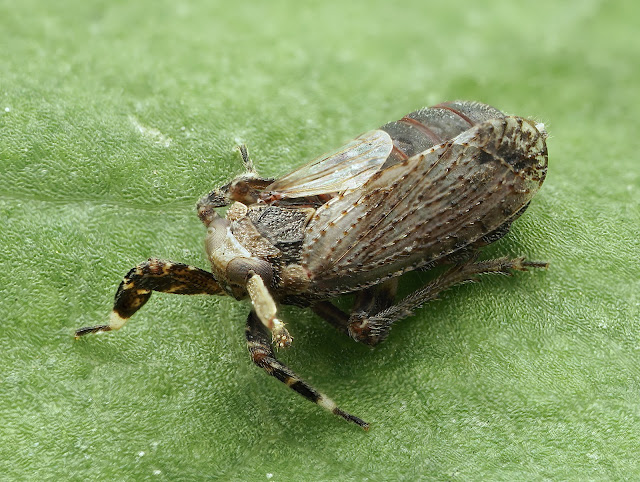A better month for entomology, although the weather put a damper on fieldwork again at the end of the month.
The Beast from the East
If you believe what you read, the weirdly alien Delphacid planthopper Asiraca clavicornis appears to be declining nationally. Except that it isn't, well not in VC55 anyway. Over the past year we have added three new sites for this species in VC55. Notably, these are possibly the three best recorded sites in the vice-county, so it seems that this bug is newly arrived, and now it's here it's spreading. My guess therefore is that this species is not so much declining as migrating north and west - a familiar theme.
My Journal, May 2024
04.v.2024
An encouraging spring feel in the garden this morning with Green-veined Whites and a Peacock on the wing. Good numbers of aphids have appeared on many plants so the bloom of Hemiptera can't be far behind.
05.v.2024
Took advantage of a beautiful spring morning to take the sweep net for its first outing of the year. Finally a feeling of entomological abundance - very good range of bugs - and I was able to put the new magnifying visor to the test.
06.v.2024
A disappointing 16/6 in the moth trap although the temperature did eventually drop off to 5C despite the cloud. Social media tells me that all moth trappers are struggling with numbers - I don't know whether to be relieved that it's not just me or alarmed at the loss of insects (it's not just moths, there's a complete lack of by-catch too).
07.v.2024
A day's "sensitive" gardening, trying to deal with the thugs without too much wildlife damage. Watching the Great Tits feeding chicks in the nestbox was a good diversion. At dusk, the widowed Blackbird belted out a lonely song from the TV aerial, and I saw the first bat of the year in the garden.
08.v.2024
Another fine day so I spent an hour tickling the Oak catkins. The summer Mirids are here.
10.v.2024
After what seemed a perfect night (warm, calm, no moon), a disappointing 4/4 in the moth trap. Another morning's garden thug refereeing. The Great Tit chicks are loud now in the nest box. In a difficult season it looks like the parents have got the timing right, plenty of caterpillars going in there.
11.v.2024
A visit to the far east - Bloody Oaks. What a magical place this is, and it didn't disappoint. I recorded a number of personal firsts, such as Turtle Shieldbug, Podops inuncta, plus putting dots on the map for quite a few species I have routinely been recording this year, greatly extending their known distribution way out east. This highlight however has to be Asiraca clavicornis, a new site for this species, see above. Ash Die-back has taken a sad toll on the Rutland verges. I fear the ratchet effect - first the Elms, now the Ash, then the Oaks?
13.v.2024
A very enjoyable afternoon outing with friends. Productive too, between us we managed to generate lots of good records, my favourite being Aradus depressus, beaten from Hawthorn.
15.v.2024
Having accumulated quite a backlog of specimens, a microscope day was in order. This turned out to be fortunate in view of the thundery showers regularly punctuating the day.
16.v.2024
More rain. More microscope.
17.v.2024
A morning gardening followed by an afternoon sorting out the hoppers from Bloody Oaks. A good range of species and thankfully my brain is not as rusty as it often is at the start of the season. Slowly some of this stuff is starting not only to sink in but to stick.
18.v.2024
Slightly more encouraging signs from the moth trap but still only 13/6. The by-catch was better however, the first microcaddis for the year and two species of (unidentifiable) Psallus.
19.v.2024
Another visit to the Far East, the land beyond the A1 - Stretton. Visited two poorly recorded woodland sites and amassed a reasonable list of species.
20.v.2024
Another day out sampling the delights of East Goscote. Specimen backlog has now reached epic proportions.
21.v.2024
A damp day specimen sorting.
23.v.2024
My new talk "A Loveliness of Ladybirds" was well attended and seemed to be well received. Some good questions at the end, only a few anti-insect ones (biting). Why are people obsessed with insects trying to kill them? Fingers crossed for the weather on the follow up walk.
25.v.2024
A late May evening, 3 moths in the trap, and one of those was a migrant Silver Y. OK, it did eventually get down to 5C and there was a full moon, but the disastrous moth collapse continues. Hogweed flowering outside the kitchen window is attracting an entertaining range of Diptera in the occasional sunny spells. In the afternoon, the Ladybird Walk in the local park was blessed with fine weather and an enthusiastic group of ladybird spotters from a wide age range. Eight species of ladybird spotted.
26.v.2024
Karma - what goes around comes around. A little bit of off-syllabus bug potting while talking about ladybirds yesterday also yielded a Pine Cone Bug, Gastrodes grossipes, plus Plesiodema pinetella, both from Scots Pine. Result!
Read previous Journal entries


















